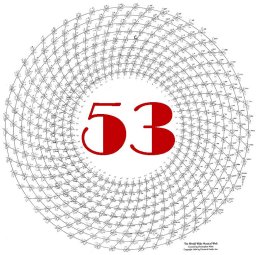Next Page: 16/6 – Sound & Color
I Ching or Tai Chi: China
The I Ching says that if you don’t accept the chance operations you have no right to use them. Which is very clear, so that’s what I do. — John Cage on using the I Ching in his chance compositions
The I Ching Book of Changes divination text goes back some 2700 years. Tossing the random heads-tails coins of the I Ching to help guide one through the future is a common practice today. As Carl Jung wrote, “The Chinese mind, as I see it at work in the I Ching, seems to be exclusively preoccupied with the chance aspect of events. What we call coincidence seems to be the chief concern of this peculiar mind, and what we worship as causality passes almost unnoticed.”
The I Ching also has strong musical possibilities. In fact, the title of the book I Ching is sometimes translated as Music of Changes. In Western music, we divide our instruments into groups according to how the sound is produced: stringed instruments by plucking or bowing, percussion by hitting, brass and wind by blowing into a tube. The Chinese grouped their instruments according to the eight different materials they were made of, and assigned them yin-yang properties. A full I Ching array offers 64 combinations of yin and yang (26), represented by six straight or broken lines (yang or yin). Three lines are adequate to represent the eight classes of musical instruments. (See Secret Power of Music by David Tame, p. 49). These eight sets of lines, or kua, represented the eight combinations of existence. (Figure 16-4)
What instrument made of Example of Instrument Nature
Stone chime Heaven
Metal bell Dampness
Silk zither Fire
Bamboo panpipes Thunder
Wood tiger box Wind
Skin drumhead Water
Gourd reed organ Mountain
Earth flute Earth
One of the first “chance” compositions by John Cage was Music of Changes, a solo piano work composed in 1951 for pianist and friend David Tudor. It is a ground-breaking piece of indeterminate music. The composition involved applying decisions made using the divinations of the I Ching. The I Ching was used to indeterminately determine charts of sounds, densities, durations, dynamics and tempi. After writing this piece, Cage wrote four books of Music of Changes, and most of his “chance” music thereafter was created using the I Ching. For example, I participated in a world premiere of a live John Cage work, Fifteen Domestic Minutes. I performed on Turntable Two in the KCFR Studio in Denver. We were linked by satellite, along with several other public radio stations, to NPR in Washington. Cage was told how many feet of albums we had in our radio stations. He’d instruct me and the other musicians to go, say, 87 feet into the records, then pull the 12th album from the left off the shelf, go to the turntable, and play it from Track 3 at 45 rpm for 36 seconds. This was happening on fifteen turntables around the country, then being outputted to hundreds of NPR radio stations. We had an incredible amount of fun doing this. I doubt the audience had much fun listening to this, several people at NPR were fired for airing it, but it was an example of a piece of music directed by the I Ching.
Many drummers also use the I Ching as a means of deriving new rhythms never thought of before.
If you would like to learn more about the ancient tunings worldwide in 53-equal you can buy the entire book, The Grand Unified Theory of Music, in pdf form for $25 with hundreds of embedded musical examples of scales and chords from all over the world.
A free introduction to what The Grand Unified Theory of Music offers is on this website and includes both text and a few musical examples from each webpage. If you would like to learn more about this chapter and the full contents of this entire e-book, you can buy The Grand Unified Theory of Music for $25, with hundreds of embedded musical examples of scales and chords from all over the world — and ideas for how to set up your computer system —
HERE.
You’ll get a personalized password you can use to see the entire e-book. Inside the full book, you will also get a link to the complete pdf file of this e-book, which you can read on your Kindle or similar device. The links to the hundreds of mp3 sound files – the same ones you can hear on the website — will also be included. This is “Version 1.0” of The Grand Unified Theory of Music. Because it is an e-book, additions, corrections and improvements in the sound may be added at any time. The Grand Unified Theory of Music is Copyright © 2018 by Christopher Mohr. All rights reserved.
One person per password. Sharing this password with others is a violation of copyright. Do not allow others to use your password or link to the pdf file!
